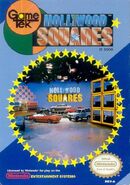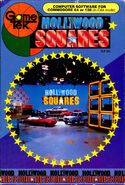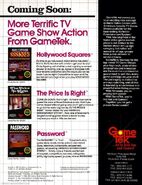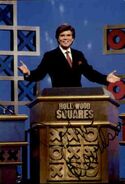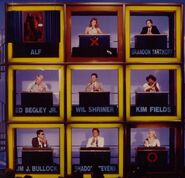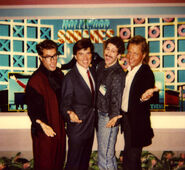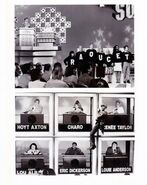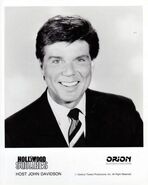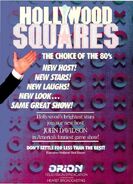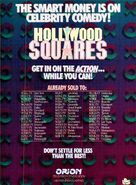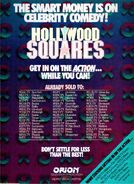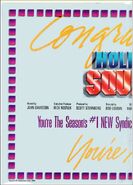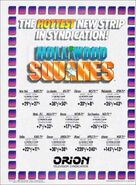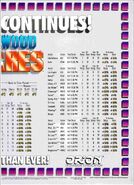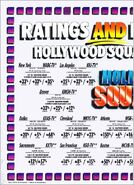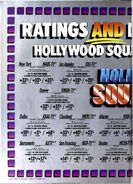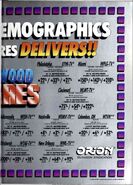| Aired | |
| Pilot, December 12, 1985 Syndicated, September 15, 1986-September 8, 1989 | |
| Run time | |
| 30 Minutes | |
| Host | |
| John Davidson | |
| Announcer | |
| Shadoe Stevens, Richard Stevens | |
| Origination | |
| NBC Studios, Burbank, California (1986); ABC Television Center, Los Angeles, California (1987); Fox Television Center, Los Angeles, California (1987-1988); Stage 37, Univversal Studios, Hollywood, California (1988-1989) | |
This is chronicling the 1986 version of The Hollywood Squares.
Game Format
Although there have been variations over the years in the rules of and the prizes in the game, certain aspects of the game have remained fairly consistent.
Two contestants, almost always a woman playing Os/naughts (called circles in the show) and a man playing Xs/crosses, took turns picking a star and following the traditional tic-tac-toe/naughts-and-crosses strategies, for which square to select. The star was asked a question and gave an answer. The contestants had the choice of agreeing with the star or disagreeing if they thought the star was bluffing. If the contestant was right, he or she got the square; if the contestant was wrong, the other contestant got the square, unless that caused the opponent to get three in a row. In that case, the opponent had to win the square on his or her own. A contestant could also win by getting five "squares" on the game board, thus preventing draws.
On rare occasions, a star would not know the correct answer to a question, but would be unable to come up with a plausible bluff. In such instances, the contestant would be offered the chance to answer the question to win or lose the square as above. Usually the contestants declined, in which case they incurred no penalty and the same star was asked another question.
1986-1989
The game used the original version's rule that games could not be won due to an opponent's error. For the first season, each game was worth $500 with a bonus of $100 per square if time ran out in the middle of a game. Beginning in season two, the third and subsequent games were worth $1,000 with $200 given for each square claimed when time ran out. If time had run out with the contestants tied, one more question was asked to one celebrity. If the contestant agreed or disagreed correctly, they won the money for one square and the match. If not, their opponent automatically won. This was also done on occasions where there was no tie, but there was only enough time for one question in a game. The contestant who finished with the most money won the match and went on to the bonus round.
Secret Square
The second game of each show was a "Secret Square" game. As with the original version, the Secret Square was revealed to the home audience at the start of this game; if a contestant chose this square and successfully claimed it, he/she won a prize (usually a trip). The prize did not increase in value from one show to the next if it was not collected.
Bonus round
The first two seasons of this version of the series employed a bonus round that was similar to the one used on the 1970s game show Split Second. Five cars, each of the same brand/make, were displayed on the stage for the entire week. The champion chose one of five keys and then chose the car they thought the key would start. The contestant also chose a good luck celebrity to sit in or stand beside the car (sometimes more, usually all nine celebrities on Friday episodes or episodes with an automatic car win for a five-time champion).
If the chosen key started the car, the contestant won it and retired; otherwise, the contestant returned the next day with that car eliminated should he or she return to the bonus game. The contestant automatically won whatever car was left on the fifth day should they have gone that far without starting the car. Since the cars were replaced every week, if a champion's reign managed to straddle weeks without having won a car, the lowest valued cars for the new week were eliminated from consideration for the champion depending on how many prior attempts were made and they were then given a choice of keys from the remaining cars.
For the final season, the car round was changed. The champion first chose a car, then one of the nine celebrities. Each held a key, with five of the celebrities holding keys that would start any one of the five available cars and four holding dud keys that did not start anything. If the champion failed to start the car, it was not eliminated from the round, but was available again if the champion returned the next day. However, the five-day limit was removed and a champion was able to stay until either winning a car or being defeated.
| This page uses Creative Commons Licensed content from Wikipedia (view authors). |
Trivia
John Davidson's process from former panelists to host also mirrors to DeRay Davis for when he was a former panelist of the original MTV2 version of Hip Hop Squares before he became the host of his version of Hip Hop Squares on VH1 since 2017.
International Versions
Merchandise
Board Game
Video & Computer Games
Ad Description
Photos
Trade Ads
TV Guide Ads
Tickets
Episode Status
Video
See Also
The Hollywood Squares
Storybook Squares
Match Game Hollywood Squares Hour
Hollywood Squares (1998)
Hip Hop Squares
Hip Hop Squares (2017)





